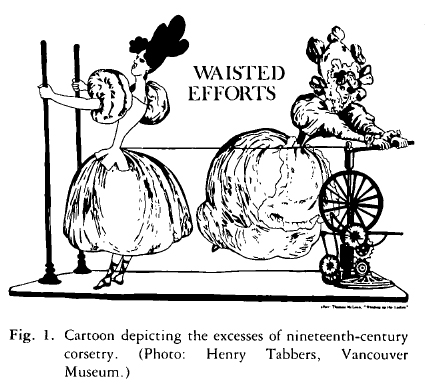Reviews / Comptes rendus
Vancouver Museum, "Waisted Efforts"
1 The History Division of the Vancouver Museum is currently presenting an exhibit of women's underwear dating from 1750 to 1960. Wryly entitled "Waisted Efforts," the exhibit focuses upon sometimes futile attempts to compress and distort the female figure into a succession of shapes, each of which was deemed fashionable in its time. Most of the artifacts displayed are mechanical contrivances designed to produce an artificial form; they range from whalebone (baleen-reinforced) corsets to wire bustles to the rubber girdles of the 1950s.
 Display large image of Figure 1
Display large image of Figure 1 Display large image of Figure 2
Display large image of Figure 22 An exhibit of underwear inevitably exercises an attraction unrelated to historical thought. History curator Ivan Sayers has deliberately interpreted the subject in a low-key, formal manner which seeks to reveal not the frilly underthings of bygone eras but rather the transition of women from constricted, ornamental beings to physically active members of society. Despite a low curatorial budget, a representative selection of artifacts is coherently interpreted on the basis of accepted historical information. The exhibit, located near the end of the museum's permanent history gallery, provides a sound chronology of the subject as well as stimulating thought on how social and economic conditions are reflected in fashion.
3 The relatively small group of artifacts displayed includes several items borrowed from the British Columbia Provincial Museum in addition to garments from the Vancouver Museum collection. The selection is not limited to items known to have been worn in British Columbia, although it is assumed that garments similar to those of foreign provenance were worn by Canadian women. Sayers was unable to present any artifacts of the period 1840-50; the trends of this decade are described in the text. The exhibit includes cheaper garments worn by working-class women as well as the high-fashion items they imitated. Wherever possible, ensembles of complementary pieces of underwear have been assembled. Generally the chronological arrangement of artifacts clearly illustrates changes in the feminine silhouette.
4 The presentation is aided by lengthy labelling and effective graphics. Reproductions of advertisements point out what was regarded as the desirable features of certain undergarments and portray contemporary concepts of the desirable woman. Contemporary cartoons satirize women's attempts to remodel their unfashionably shaped bodies, and illustrations of outer garments demonstrate the shapes women sought to achieve by means of concealed engineering. A brochure accompanying the exhibit provides insights into relationships between feminine fashion and other aspects of material culture, for example, the manufacture of chairs without arms to accommodate the huge hooped skirts of the 1860s.
 Display large image of Figure 3
Display large image of Figure 35 The theme of this exhibit would be more explicit if the text placed greater emphasis on the influence of political, social, and economic factors upon fashion. Although the well-known influence of two world wars on women's work and apparel is referred to, additional factors ranging from the French Revolution to the bicycle fad of the 1890s might have been mentioned. Sayers stated that he expected viewers to draw their own conclusions on women's social role as revealed in the construction of their underwear. An illustrated lecture complementing the exhibit promised to explore this theme in more detail.
6 Designer Mary Paddon altered an existing group of cases, whose mauve backgrounds are surprisingly warm and attractive, to produce an enclosed exhibit area. Most of the garments displayed are set off by plain black dress forms, but store display forms with interior light bulbs are used effectively to reveal the structure of "foundation garments" of the 1950s. There is one major design flaw: a blind corner near the end of the exhibit leads the viewer to proceed directly from a case containing turn-of-the-century undergarments to a case concerned with the 1950s. Not until later does one catch sight of a nook interpreting the intervening period.
7 The rather conservative interpretation and design of this exhibit provide reliable historical information, and the low-key display is a visual relief for the visitor over-taxed by complex and dramatic presentations. The theme of the exhibit is thought provoking and has greater potential than is tapped by the established information used in the text. The theme is not strongly stated, and one wonders if the straightforward chronological approach taken would sustain the viewer's interest if the subject itself did not exercise a peculiar attraction.